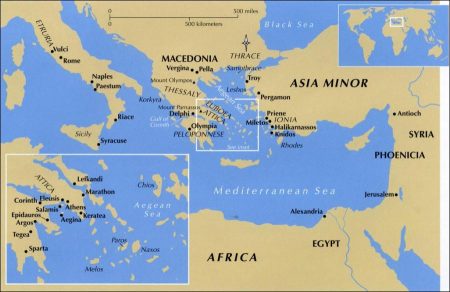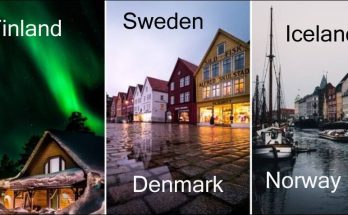The Mediterranean Sea was the heart of the Old World; the important lands of the early history of civilization were grouped about its richly indented shores, generally decreasing in respect of culture as they receded from it. The northeastern part of the Mediterranean, because of its many islands, having an even greater proportionate coast-line, was the centre of the countries ennobled by Hellenic civilization.
Separating and uniting at once, like all the waters of the earth, the Aegean Sea formed the boundary between the two chief races of Greek intellectual life–the Dorians and the Ionians; while it was, at the same time, the favoring medium of exchange for the productions of their genius. European Greece, with its predominating Doric population, and the almost exclusively Ionic coasts of Asia Minor, equally looked upon this sea as their own, traversing it with thousands of ships, and gaining more from the trackless waters before them than from the interior lands of the immense continents whose seaboard alone they were content to occupy.
In Asia the Greeks were restricted to the countries upon its uttermost western border; in European Greece the development was chiefly directed towards the eastern coast, paying even less attention to their own shores on the Adriatic than to the early colonized ports of Magna – Graecia and Sicily. The Archipelago itself provided convenient strongholds and outposts in every direction. The numerous harbors and anchoring – places of its many islands offered protection against the notorious treachery of the Aegean main–a protection imperatively necessary for the primitive seafarers of antiquity. But, as in the history of all civilization, the currents of Greek intellectual and artistic progress moved distinctly from east to west.
The European (Doric) culture was in itself less calculated to influence Asia than the Asiatic (Ionic) to affect the younger continent. It was, as decided by nature, upon European soil, upon Attica–the most advanced promontory of European Greece–that the two branches of the Greek race united, and bore in Athens that double fruit at which we marvel. The Dorians, displaced, in some measure, by the rapid growth of Ionic Asia and Europe, turned still farther westward, and settled upon the shores of Sicily and the Gulf of Tarention, where imposing monuments still attest the extent of their power.
The legends of the wanderings of Hellenic tribes, and especially of the so-called Doric migration, were based upon the busy currents of intercourse between Asia and Europe, over seas and straits, and between the European continent and the Morea, the Island of Pelops. The relations and the quarrels of Hellenic and semi-barbaric peoples upon each side of the Aegean are illustrated by the tales of the Argonauts and their voyage, and of the Trojan War, both of which bear the stamp of a certain piratical rivalry.
The fatal lack of unity, resulting from the separate development of neighboring districts, could not be more distinctly characterized than by the fact that the Greek races, although they felt themselves divided from other nations — from barbarians — by an impassable gulf, and were aware of their own absolute intellectual superiority, yet lacked any comprehensive designation for themselves: the name Greeks, or Hellenes, is of comparatively recent origin.
Visits: 555



